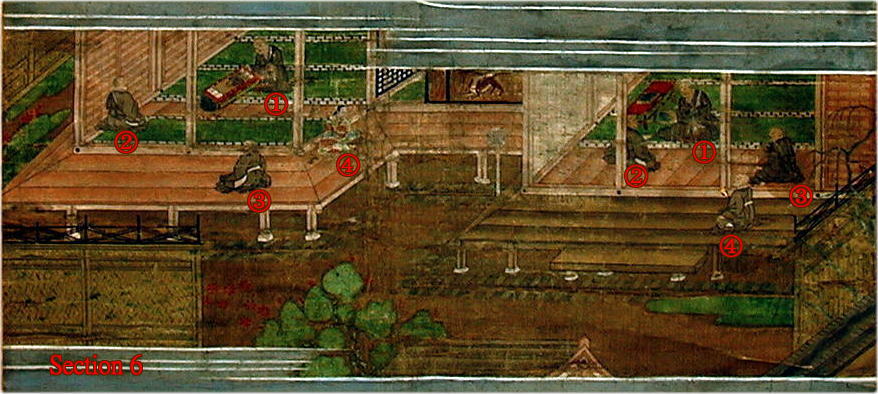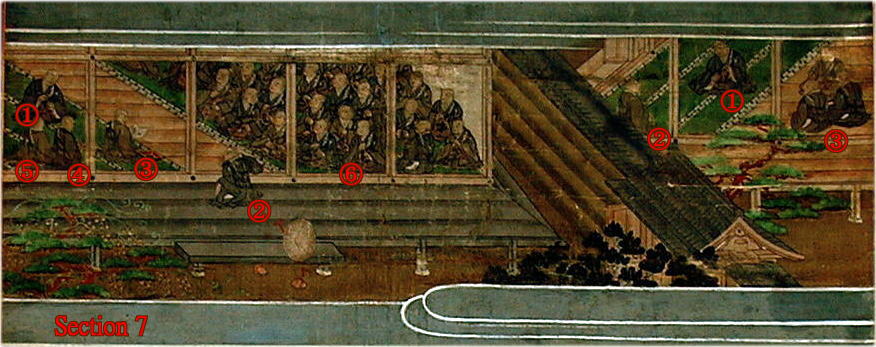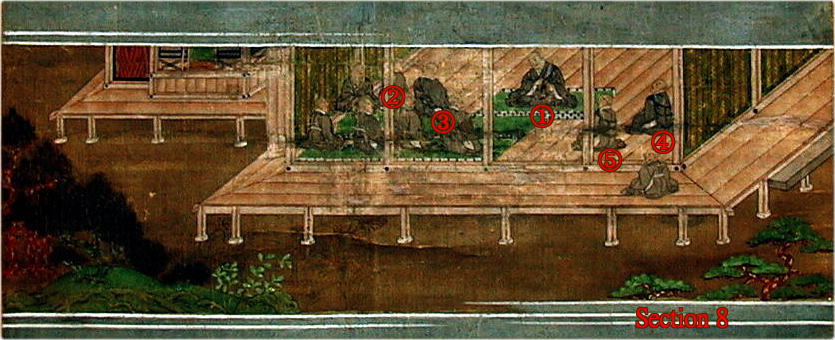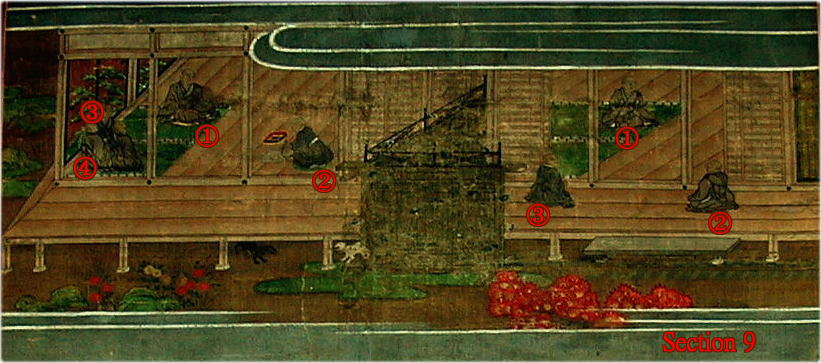An Illustrated Biography of Shinran, the Honganji Shonin
(Honganji Shonin Shinran Denne)
Compiled by Kakunyo
Introduction, translation and notes
by Zuio H. Inagaki
Go to Index to Shinran denne;Sukhavati-Index; General Index
5
When the Virtuous Master of Kurodani,(1) Genku, was still in the world, out of compassion,
he granted Shonin permission to copy his
work,(2) and on another occasion, wrote Shonin's
new name(3) in his own hand. It is stated in A Collection of Passages Revealing the Provisional
Transformed Buddhas and Lands of the Pure
Land Way, Chapter 6, [compiled by Shinran Shonin]:
I, Gutoku Shinran, disciple of Shakyamuni,
abandoned sundry practices and took refuge
in the Primal Vow in the first year of Kennin,
the year of metal/cock.(4) In the year wood/ox of the Genkyu era,(5) with the master's kind permission, I copied
his Collection of Passages Concerning the Nembutsu
of the Best-Selected Primal Vow. In the same year, on the fourth day of the
middle part of the fourth month, the master,
in his own hand, inscribed the following
on the inside of my copy, "A Collection of Passages Concerning
the Nembutsu of the Best-Selected Primal
Vow," and the words, "Namu amida butsu: The fundamental act for
the attainment of birth is the Nembutsu,"
and also my new name, "Shakku, disciple
of Shakyamuni." On the same day, I borrowed
the master's portrait and copied it. In the
same second year [of Genkyu], on the ninth
day of the latter part of the seventh intercalary
month, the master inscribed on my copy of
the portrait "Namu amida butsu" and the passage of the true teaching:
"If, when I become a Buddha, all sentient
beings in the ten quarters who call my Name
even ten times fail to be born in my land,
may I not attain perfect Enlightenment. This
Buddha, having attained Buddhahood, now dwells
in the Pure Land. You should know that his
weighty vows are not in vain. Sentient beings
who call his Name will unfailingly attain
birth."(6) On the same day, he also wrote on the portrait
my new name [Zenshin] to which my former
name 'Shakku' was changed according to a
revelation in a dream. The master was then
seventy-three years old.
A Collection of Passages Concerning the Nembutsu
of the Best-Selected Primal Vow was compiled at the request of the Chancellor,
the ordained layman [Lord Tsukinowa Kanezane,
Buddhist name Ensho]. The essentials of the
true teaching of the Pure Land way and the
profound doctrine of the Nembutsu are contained
in it. Those who read it can easily understand
it. It is indeed an incomparable and supreme
collection of fine passages, an unsurpassed
and profound scripture. Out of the thousands
of people who received his teaching, personally
or otherwise, over many days and years, very
few were allowed to read and copy this work.
Nevertheless, I was allowed to copy it and
also make a copy of his portrait. This is
the benefit of the exclusive practice of
the Right Act; this is a sure proof of my
future attainment of birth. With tears of
sorrow and joy, I have noted the above story.
Notes:
1. Kurodani, lit. 'Black Valley'; the name
of a valley in the Saito (Western Pagoda)
Precinct of Mt. Hiei, where there is a temple
called Seiryuji. Those who sought emancipation
while leading a quiet life of seclusion lived
here. When Eiku ( -1179), an adept of the
Tendai precept of perfect fusion and Yuzu
Nembutsu, was living here, Honen, at the
age of 18, came here and studied under him.
Later, Honen returned and perused the whole
collection of Buddhist scriptures in the
Hoonzo Library. When he was reading them
for the fifth time, at the age of 43, he
came across the passage recommending exclusive
practice of the Nembutsu in Shan-tao's commentary
on the Comptemplation Sutra. This brought him deep awareness of
Amida's Vow of salvation through the Nembutsu.
For this reason, Honen is often called 'the
Master of Kurodani.'
2. Refers to Senjakushu (or Senchakushu); the full title is Senjaku Hongan Nembutsu-shu (A Collection of Passages Concerning the Nembutsu
of the Best-Selected Primal Vow), compiled by Honen in 1198 at the request
of Fujiwara Kanezane. This work justifies
the Nembutsu as the most effective method
of salvation, and its publication marked
the independence of the Jodo school.
3. Honen inscribed a new name of Shinran,
Shakku, on the copy of Honen's portrait.
4. This corresponds to the year 1201 A.D.
5. This corresponds to the year 1205 A.D.
6. The Eighteenth Vow adapted by Shan-tao.

Section 6
<Right>
1. Honen, at the age of 73, handing the Senjakushu to Shonin.
2. Shinran, at the age of 33, receiving the
Senjakashu.
3. Honen's disciple, possibly, Seikaku.
4. An attendant novice.
<Left>
1. Honen inscribing the Sacred Name and a
quotation from the Liturgy for Birth on Shonin's copy of Honen's portrait. Shonin's
new name, Zenshin, was also added to it.
2. Shonin.
3. Honen's disciple.
4. An attendant novice.
6
In bygone days, when Genku Shonin was still
alive and propagated the teaching of birth
in the Pure Land by the Other-Power, the
whole country was receptive to, and took
refuge in it. Those at the helm of state
in the Imperial Palace yearned for the blossoms
in the golden forests, and the ministers
and high officials in charge of government
administration admired the moon of the Forty-eight
Vows. In addition, country-folk in remote
places and the general public all upheld
and revered the teaching. The noble, as well
as the underprivileged, went to see Honen
in great numbers. So great were the numbers
that his hermitage was as crowded as a market.
It is said that the priests alone, in close
attendance upon him, amounted to more than
three hundred and eighty. Be that as it may,
only very few actually received the master's
personal instructions and closely followed
them. Their number was hardly more than five
or six.
One day, Zenshin Shonin [Shinran] said to
the master, "I have abandoned the Path
of Difficult Practice and come to the Path
of Easy Practice; I have left the Gate of
the Sacred Path and entered the Pure Land
Gate. Without your kind instructions, how
could I have attained the propitious cause
for emancipation? What a joy it is! Nothing
can compare with this. As I reflect, however,
although I have developed friendly ties with
many of your disciples and share with them
the opportunity to receive your teaching,
none of us realize who among us have settled
Faith for attaining birth in the True Land
of Recompense and who have not. For this
reason, in order to ascertain who will be
my true friends in the life to come and also
for the sake of keeping the record of happenings
in this ephemeral world, I wish to present
a question at the gathering of your disciples,
asking about their inner hearts."
The Great Master, [Genku] Shonin, replied,
"Your proposal is most reasonable. You
may ask them when they come here tomorrow."
At the gathering the next day, Shonin declared,
"Today, your seats are divided into
two sides: one side is for those who are
steadfast in faith and the other for those
who are steadfast in practice. Please be
seated on one or the other side."
The fellow-disciples, numbering more than
three hundred, appeared puzzled, not understanding
Shonin's intention. At that time, it is said
that Seikaku, who held the rank of the Dharma-seal
great master,(1) and Horen, Shaku Shinku Shonin, said, "I
will be on the side of steadfast faith."
Next, Novice Horiki [Kumagai Naozane Nyudo]
who came late asked, "What is your intention
of keeping a record, Zenshin-bo?"
Zenshin Shonin replied, "Two seats are
provided: one for steadfast faith and the
other for steadfast practice."
Horiki said, "Let me, Horiki, join you.
I will be on the side of steadfast faith."
Shonin wrote down Horiki's name in his note.
Although a few hundred disciples were assembled
there, no one spoke out. This probably shows
that they were clinging to the delusory mind
of self-power and so did not realize the
diamond-hard True Faith. While silence prevailed
in the hall, Shonin noted down his own name.
A little later, the Great Master said, "I,
Genku, will join the side of steadfast faith."
At that moment, some of the disciples were
overcome with the feeling of awe and respect,
while some others appeared downcast with
shame.
Note:
1) This is the highest of the three higher
ranks of priesthood, corresponding to the
older term sojo (abbot).

Section 7
<Right>
1. Honen, at the age of 73, listening to
Shonin's proposal.
2. Shonin advancing a proposal to divide
his fellow-disciples into two: those who
upheld faith and those who believed in practice.
3. Honen's chief disciples.
<Left>
1. Honen.
2. Rensho-bo who came late asking Shonin
about the purpose of the meeting.
3. Shonin chairing at the meeting.
4 & 5. Seikaku and Shinku seated on the
"faith" side.
6. More than 300 disciples of Honen seated
on the "practice" side.
7
Shonin related the following episode.
A long time ago, when many disciples, including
Shoshin-bo, Seikan-bo and Nembutsu-bo, were
in the presence of the Great Master, [Genku]
Shonin, an unexpected dispute took place.
The dispute began when I said, "The
Master Shonin's faith and Zenshin's faith
are not different in the least; they are
one and the same."
They argued against me, saying, "Zenshin-bo's
remark that the Master's faith and his faith
are the same is unreasonable. How could they
be the same?"
Zenshin, replied, "Why don't you
say that they are the same? It would be preposterous
to say that the Master's wisdom which is
deep and extensive is equal to mine. As for
faith for birth in the Pure Land, ever since
I discovered 'Faith of the Other-Power,'
I have not conceived any thought of 'I' or
'mine.' The Master's Faith has been endowed
by the Other-Power; Zenshin's Faith is also
that of the Other-Power. For this reason,
I say that his Faith and mine are the same."
Then the Great Master made a clear remark,
saying, "If one's faith is different
from another's, they are, after all, faith
of self-power. If one's wisdom of understanding
is different from other's, one's faith is
also different from another's. Faith of the
Other-Power is endowed by the Buddha to ordinary
people, whether they are good or evil; hence,
Genku's Faith and Zenshin-bo's Faith are
not different, but they are one and the same.
We do not entrust ourselves to Amida because
we are wise and intelligent. If your faith
is different from mine, you cannot possibly
be born in the same Pure Land where I shall
be born. You should discern this well."
In total consternation, those present were
speechless, and so the discussion came to
an end.

Section 8
1. Honen at the age of 74.
2. Shonin at the age of 34 sitting behind
a pillar.
3. Nembutsu-bo.
4. Shoshin-bo.
5. Seikan-bo.
8
Shonin's disciple, Nyusai-bo, cherished a
desire to have a portrait of Shonin. Knowing
this, Shonin said to him, "You can ask
the Dharma-bridge(1) Jozen [who lived in Shichijo] to portray
me."
Elated by Shonin's suggestion based on deep
observation, Nyusai-bo invited the Dharma-bridge
to Shonin's abode. Jozen came at once as
requested. The moment Jozen saw Shonin, he
said, "Last night I had an inspired
dream. The holy priest I saw in the dream
is exactly the same person as I now see before
my eyes."
With profound joy and awe, he continued,
"Two noble priests came to visit me.
One of them said, 'I wish to have a portrait
of this revered incarnated one made. Please
make one, Jozen.' So I asked, 'Who is this
incarnated one?' The priest replied, 'He
is the founder(2) of the Zenkoji Temple.' I prostrated myself
on the floor with my hands joined together,
and thought to myself in the dream, 'He must
be a living incarnation of Amida Tathagata.'
Feeling my hair standing on end, I deeply
revered and paid homage to him. The priest
added, 'A portrait of his face will be enough.'
After the exchange of these words, I awoke
from the dream. As I now see Shonin's august
countenance at this hermitage, it is not
a bit different from the holy priest that
I saw in the dream."
So saying, Jozen shed tears of great joy.
Shonin remarked, "Let my portrait be
just as you saw in your dream."
So Jozen portrayed Shonin's face only. Jozen
had this dream in the night of the twentieth
day of the ninth month in the third year
of Ninji.(3)
As I deeply contemplate this miraculous and
portentous event, I clearly see that Shonin
was an incarnation of Amida Tathagata. It
follows then that the teaching he promulgated
was most likely Amida's direct exposition.
Amida holds up the brilliant lamp of undefiled
wisdom to disperse the darkness of delusion
in the world of defilement; furthermore,
he showers the rain of Dharma everywhere
in order to moisten the dried-up hearts of
ordinary and deluded beings in the distant
future. Let us revere and entrust ourselves
to his teaching.
Notes:
1. The Dharma-bridge: 'Hokkyo' in Japanese,
an abbreviation of 'hokkyo-shonin-i,' 'the rank of the Master of Dharma-bridge';
originally, the lowest of the three higher
ranks of priesthood, which corresponds to
the older term 'risshi'. Later, used as a title of honor for medical
doctors, painters, poets, and so on.
2. Founder; 'hongan no onbo' in Japanese; here 'hongan' does not mean 'primal vow,' but 'a founder
or promoter' of a temple, statue, or a Dharma-meeting.
3. This corresponds to 1242.

Section 9 Shonin's hermitage in Kyoto
<Right> Nyusai's wish to have Shonin's
portrait.
1. Shonin at the age of 70 granting Nyusai-bo's
wish..
2. Nyusai-bo.
3. Ren'i-bo.
<Left> The painter, Jozen, seeing Shonin
1. Shonin poised for being portrayed.
2. Jozen portraying Shonin.
3. Nyusai-bo.
4. Ren'i-bo and another disciple.
 Go to Next File; return to Index to Shinran denne;Sukhavati-Index; General Index
Go to Next File; return to Index to Shinran denne;Sukhavati-Index; General Index





![]() Go to Next File; return to Index to Shinran denne;Sukhavati-Index; General Index
Go to Next File; return to Index to Shinran denne;Sukhavati-Index; General Index